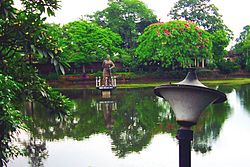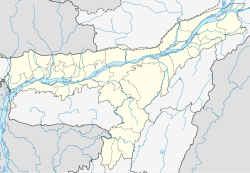Tinisukia
|
Tinsukia তিনিচুকীয়া City of Ponds |
|
|---|---|
| City | |

|
|
| Location in Assam, India | |
| Coordinates: 27°30′00″N 95°22′01″E / 27.500°N 95.367°ECoordinates: 27°30′00″N 95°22′01″E / 27.500°N 95.367°E | |
| Country |
|
| State | Assam |
| District | Tinsukia |
| Government | |
| • Body | Tinsukia Municipality Board |
| Elevation | 116 m (381 ft) |
| Population (2011) | |
| • Total | 99,448 |
| Languages | |
| • Official | Assamese |
| Time zone | IST (UTC+5:30) |
| PIN | 786125 |
| Telephone code | 91-374 |
| ISO 3166 code | IN-AS |
| Vehicle registration | AS -23 |
| Website | www |
Tinsukia (Pron: ˌtɪnˈsʊkiə) (Assamese: তিনিচুকীয়া) is a city and municipal board in Tinsukia district, Assam, India. It is situated 480 kilometres (298 mi) north east of Guwahati and 84 kilometres (52 mi) kilometres away from the border with Arunachal Pradesh.
It is the administrative headquarters of Tinsukia District of Assam, India. It contains a mixture of Assamese, and Hindi- speaking people. New malls and buildings are being constructed.
Tinsukia deals in agricultural products such as tea, oranges, ginger, citrus fruits and paddy. It also contains the state's largest railway junction.
Tinsukia is the site of Bengmara, which was originally known as Changmai Pathar. It was the capital city of the Muttack Kingdom which was founded by Swargadeo Sarbananda Singha.
Swargadeo Sarbananda Singha, known as Mezara, rose to become an able administrator. Mezara adopted the name Sarbananda Singha after he became the King. Swargadeo Sarbananda Singha introduced coins after his name and in Saka 1716 and 1717, he inscribed the title Swargadeo in the coins.
As instructed by Swargadeo Sarbananda Singha, his Minister Gopinath Barbaruah alies Godha dug a triangular pond which is known as Tinikunia Pukhuri. In 1884 a station was constructed near this pond, when the Dibru-Sadiya Rail line was laid, which was named as Tinsukia. Since then it has been known as Tinsukia.
Tinsukia is located at 27°30′N 95°22′E / 27.5°N 95.37°E. It has an average elevation of 116 metres (380 feet).
...
Wikipedia


